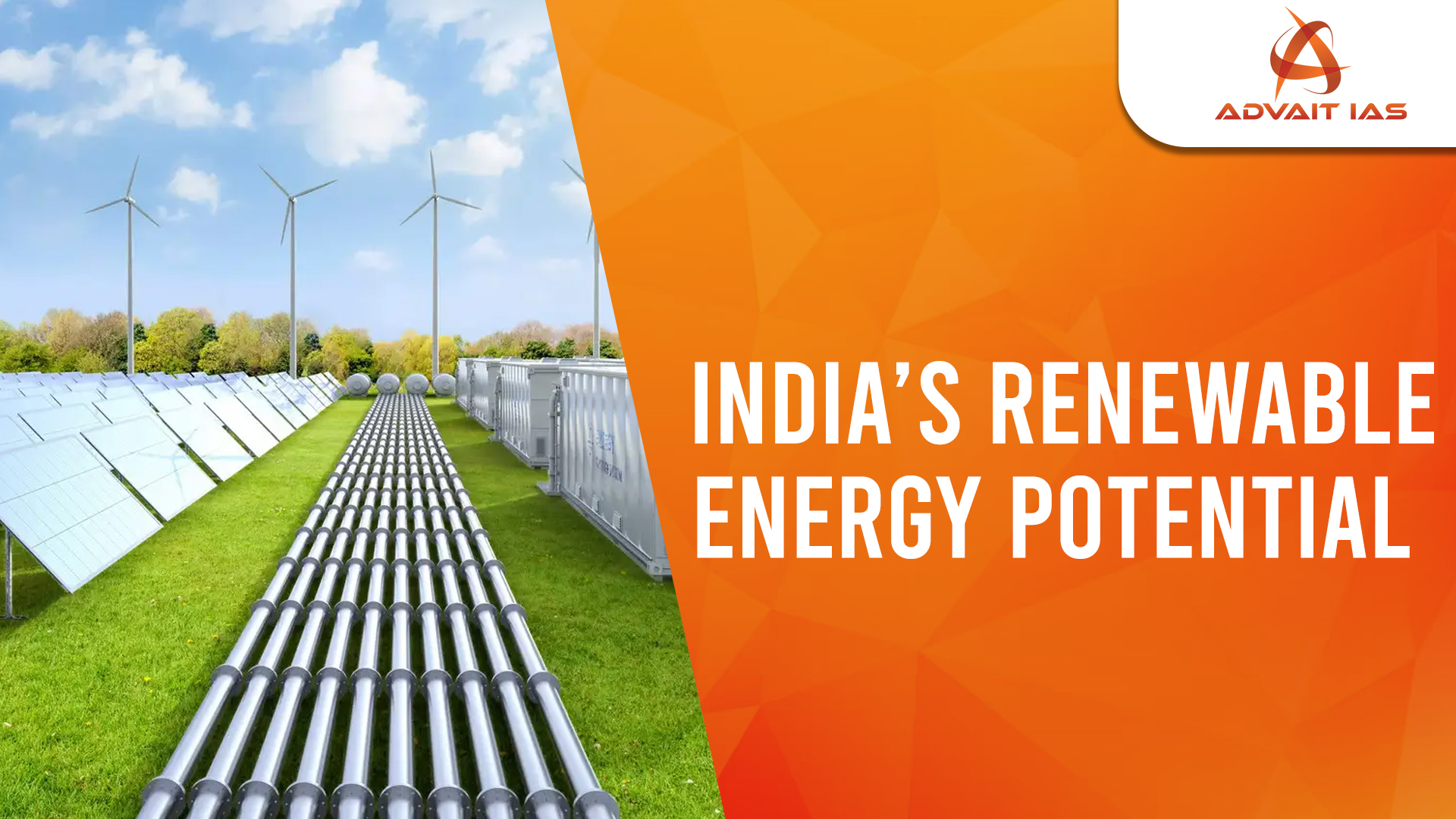The government has launched various schemes aimed at promoting renewable energy, enhancing grid stability, and reducing carbon emissions.
Key initiatives such as the National Bio Energy Mission, National Green Hydrogen Mission, PM-KUSUM, and PM Surya Ghar Muft Bijli Yojana, reflect the nation’s commitment to a cleaner and self-reliant energy future.
As of January 2025, India’s total non-fossil fuel-based energy capacity has reached 217.62 GW.
- Total Renewable Energy Potential (as of March 2024): 21,09,655 MW
- Breakdown of Renewable Energy Potential:
- Wind Power: 11,63,856 MW (~55%)
- Solar Energy: 7,48,990 MW
- Large Hydro: 1,33,410 MW
- Top 4 States with Highest Renewable Energy Potential:
- Rajasthan – 20.3%
- Maharashtra – 11.8%
- Gujarat – 10.5%
- Karnataka – 9.8%
Growth in Installed Renewable Energy Capacity
- March 2015: 81,593 MW
- March 2024: 1,98,213 MW
- CAGR: 36%
Growth in Renewable Energy Generation
- FY 2014-15: 2,05,608 GWH
- FY 2023-24: 3,70,320 GWH
- CAGR: 76%
Per Capita Energy Consumption Growth
- FY 2014-15: 14,682 MJ/person
- FY 2023-24: 18,410 MJ/person
- CAGR: 55%
Key Achievements in 2024
- Total Non-Fossil Fuel Energy Capacity (as of Jan 20, 2025): 62 GW
- Renewable Energy Additions in 2024:
- Solar Energy: 5 GW (2x increase from 2023)
- Wind Energy: 4 GW (21% rise from 2023)
Solar Energy Growth
- Utility-Scale Solar: 5 GW added (2.8x increase from 2023)
- Top Performing States (71% of total installations):
- Rajasthan
- Gujarat
- Tamil Nadu
- Rooftop Solar: 59 GW added (53% increase from 2023)
- PM Surya Ghar: Muft Bijli Yojana led to 7 lakh rooftop solar installations.
- Off-Grid Solar: 48 GW added (182% increase).
Wind Energy Growth
- Total New Capacity in 2024: 4 GW
- Top States for Wind Installations:
- Gujarat – 1,250 MW
- Karnataka – 1,135 MW
- Tamil Nadu – 980 MW
- These states accounted for 98% of new wind capacity additions.
Policy & Infrastructure Developments
- Green Hydrogen Push: Government initiated policies to lower costs and attract investments.
- Manufacturing Expansion: Scaling up of solar PV and wind turbine manufacturing to establish India as a global RE hub.
- Grid Infrastructure Development: Investments in inter-state transmission systems to evacuate power from renewable-rich states (Rajasthan, Gujarat, Madhya Pradesh).
The CCDC Wind Initiative has significantly enhanced wind energy development, leading to 48.16 GW of installed capacity.
The National Green Hydrogen Mission, launched in 2023, is positioning India as a global leader in hydrogen energy with investments exceeding ₹8 lakh crore.
The National Solar Mission has propelled solar energy growth, with installed capacity rising from 9.01 GW in 2016 to 97.86 GW in 2025.
Additionally, PM-KUSUM and PM Surya Ghar Muft Bijli Yojana are accelerating solar adoption among farmers and households.
Future Outlook (2025 & Beyond)
- Target: 500 GW of non-fossil fuel energy capacity by 2030.
- Challenges:
- Regulatory hurdles
- Financial constraints
- Infrastructure development
- Opportunities:
- Increased investment
- Technological advancements
- Continued policy support
India’s renewable energy transition is accelerating, with 2024 setting the foundation for sustained growth and leadership in the global clean energy sector.
- India has seen a steady rise in energy supply and consumption.
- Electricity transmission and distribution losses have been reduced.
- The industry sector was the fastest-growing energy-consuming sector in FY 2023-24.
This growth highlights India’s commitment to renewable energy expansion and energy efficiency improvements.






